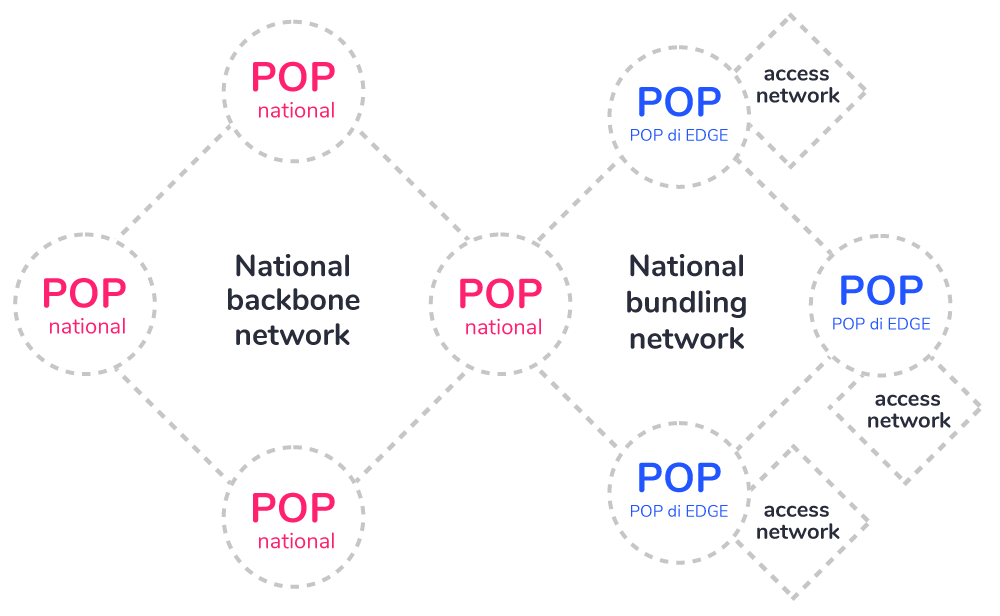Open Fiber’s FTTHFTTH “Fiber to the Home” is the technology that connects POPs, located in exchanges, to end users’ property units with fiber optics. access networkNetwork In computer language, the term network defines a set of hardware and software devices which, when linked together, enable the exchange and sharing of resources, data or information. In a computer network, the devices that generate, route and terminate data are called network nodes. is built according to the PONPON PON stands for Passive Optical Network, which describes all types of optical networks that have no active equipment between the start and end point. One of these is the network used to bring the fiber-optic link to the end-user by means of point-to-multipoint architecture in which a single fiber is used to reach several recipients via non-powered optical splitters. (Passive Optical Network) standard, respecting its evolutionary roadmap to guarantee the best connection ever.
Open Fiber’s network infrastructure uses GPONGPON An acronym for Gigabit Passive Optical Network, an active access technology for providing connectivity over PON FTTH infrastructure. It is defined as active because it is implemented using active network elements such as OLTs, in the central office, and ONTs, in users’ homes. However, the underlying network infrastructure is passive (Passive Optical Network) because it exclusively uses elements that do not require power, such as splitters that allow the optical fiber to be separated into multiple links that branch off to different buildings, reducing the amount of optical fiber and network equipment required. GPON technology provides unprecedented bandwidth (up to 2.5 Gbps downstream and 1.25 Gbps upstream) and greater distance from the exchange, allowing service providers to enable bandwidth-intensive applications. fixed access technology, the most robust on PON networks to date. GPON technology has recently seen the addition of more advanced technologies: XGS PON (a fiber-optic link that can transmit and receive data at a maximum speed of 10 Gbit/s) and the subsequent NG-PON evolution (a telecommunications network standard capable of reaching a total surfing speed of 40 Gbit/s) to achieve higher performance in terms of transmission capacity.
Comparing PON and AON technology
Passive Optical Network (PON) technology enables the creation of fiber-optic FTTH network infrastructure in point-to-multipoint mode, using only fiber and passive components, such as optical splitters and couplers, which, installed along the entire transmission route, do not need to be powered by the electricity grid. The need for direct supply is therefore limited to the exchange/POPPOP The POP, ‘Point of Presence’, is located at Enel’s Primary Cabins, but not exclusively; it also acts as a meet-me-room for Operators. It contains each Operator’s OLT equipment, as well as the OTDR monitoring system. level. These aspects are one of the major advantages of the technology, reducing costs and the possibility of failure, in contrast to copper networks.
As an alternative to the passive optical network, an end-user connection can be made using an Active Optical Network (AON). This configuration involves point-to-point architecture, i.e. Featuring dedicated fiber with the use of active equipment (switches, routers). Although the Active Optical Network system is mature and functioning, the resulting implementation cost is higher than that of the passive optical network (PON).
Open Fiber’s architecture
Open Fiber’s FTTH access network is a passive multi-operator network that supports the use of ‘point-to-multipoint’ and ‘point-to-point’ technologies.
Open Fiber’s ‘point-to-multipoint’ architecture is based on the creation of a network in which the optical concentration resources (PON trees) are shared by the different actors, while the final connection to the user is created with a single dedicated fiber.
To enable the efficient gathering of users, a network element was introduced, consisting of a permutation box (coinciding with the PFSPFS The PFS is the node at which the second level of splitting and permutations of customer lines on the various Operators take place. node), which allows each customer to be flexibly connected to the optical resources of the Operator with which they have subscribed to the service.










